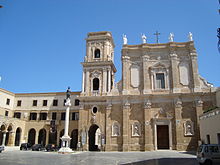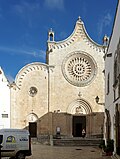Archdiocese of Brindisi-Ostuni
| Archdiocese of Brindisi-Ostuni | |
| Basic data | |
|---|---|
| Country | Italy |
| Church region | Apulia |
| Ecclesiastical province | Lecce |
| Metropolitan bishopric | Archdiocese of Lecce |
| Diocesan bishop | Domenico Caliandro |
| Emeritus diocesan bishop |
Rocco Talucci Settimio Todisco |
| surface | 1,254 km² |
| Parishes | 59 (2018 / AP 2019 ) |
| Residents | 269,900 (2018 / AP 2019 ) |
| Catholics | 265,560 (2018 / AP 2019 ) |
| proportion of | 98.4% |
| Diocesan priest | 119 (2018 / AP 2019 ) |
| Religious priest | 33 (2018 / AP 2019 ) |
| Catholics per priest | 1,747 |
| Permanent deacons | 13 (2018 / AP 2019 ) |
| Friars | 66 (2018 / AP 2019 ) |
| Religious sisters | 141 (2018 / AP 2019 ) |
| rite | Roman rite |
| Liturgical language | Italian |
| cathedral | Cattedrale di San Giovanni Battista in Brindisi |
| Co-cathedral | Concattedrale di Santa Maria dell'Assunzione in Ostuni |
| Website | www.brindisiostuni.it |
The Roman Catholic Archdiocese of Brindisi-Ostuni ( Latin Archidioecesis Brundusina-Ostunensis , Italian Arcidiocesi di Brindisi-Ostuni ) is in Italy situated Roman Catholic archdiocese , based in Brindisi .
history
Early Christianity
Due to its location in the center of the Mediterranean Sea , Brindisi was one of the first places in the West to come into contact with Christianity . Ships coming from Syria and Palestine have docked here since ancient times, and travelers made their way to Rome via the Via Appia . Dionysius of Corinth wrote around 170 that the apostle Peter could also have landed here. Ignatius of Antioch followed on his journey from Syria to Rome, which led via Philadelphia , Smyrna , Troas , Naples , Dyrrhachium and Brindisi , also from here on the Via Appia.
In the 3rd century, Brindisi, Canosa , Troia , Lucera and Salapia are evidenced as episcopal residences in what is now Apulia . The Metropolitan of Brindisi, Marco, was one of the seven western participants, and the only one from the Italian peninsula, who attended the First Council of Nicaea in 325 . Athanasius , who in 357 seems to refer to the monks of Terra d'Otranto as recipients of his Vita Antonii , was present here as the companion of the Patriarch Alexander of Alexandria .
The diocese of Brindisi was established in the 4th century . In the 5th century, refugees from North Africa found refuge in Salento , who - as Victor von Vita writes 484 - hoped to escape the persecution by the Arian vandals here .
middle Ages
At the end of the 6th century the dioceses of Gallipoli , Lecce and Brindisi were without a bishop. Pope Gregory I commissioned the Bishop of Otranto to visit these episcopal see to demand the election of new bishops. In 601 he instructed Peter to remove the relics of Saint Leucius from Brindisi and send them to Opportunus , the abbot of the monastery in Rome dedicated to that saint.
In the course of the monotheletic dispute , Pelinus , a Basilian from Dyrrachium , moved to Brindisi with the Syrians Gorgonios and Sebastios and his pupil Cyprius in 648 , because he did not share the monotheletic theology of the Byzantine emperor Constans II . Like his companions, he took an Orthodox position and therefore sought refuge in Brindisi. He was elected bishop of Brindisi, but officials of the emperor deposed him and sent him to Corfinio , where he and his companions were probably killed in 662.
In the 10th century, the diocese of Brindisi was elevated to an archdiocese. The dioceses of Ostuni and Monopoli were subordinated to the Archdiocese of Brindisi as suffragan dioceses .
Modern times
On May 14, 1821, the Archdiocese of Brindisi was annexed by Pope Pius VII with the Apostolic Constitution De utiliori, the Diocese of Ostuni. The Archdiocese of Brindisi lost its status as a metropolitan diocese on October 20, 1980 through the Apostolic Constitution Conferentia Episcopalis Apuliae and was subordinated to the Archdiocese of Lecce as a suffragan. On September 30, 1986, the Archdiocese of Brindisi was renamed the Archdiocese of Brindisi-Ostuni by the Congregation for the Bishops with the decree Instantibus votis .
See also
- List of the Archbishops of Brindisi
- List of the bishops of Ostuni
- List of Roman Catholic Dioceses
- Roman Catholic Church in Italy
Web links
- Official website (Italian)
Individual evidence
- ↑ a b c d e Giacomo Carito: 1 - secoli I – VII. In: Storia dell'Arcidocesi. Centro Studi per la Storia dell'Arcidocesi di Brindisi-Ostuni, accessed on February 21, 2020 (Italian).
- ↑ a b c Entry on the Archdiocese of Brindisi-Ostuni on catholic-hierarchy.org (English)
- ↑ Ioannes Paulus II : Const. Apost. Conferentia Episcopalis Apuliae , AAS 72 (1980), n.8, pp. 1076f.
- ^ Congregatio pro Episcopis: Decretum Instantibus votis , AAS 79 (1987), n. 6, p. 668ff.
Cathedral of San Giovanni Battista in Brindisi


